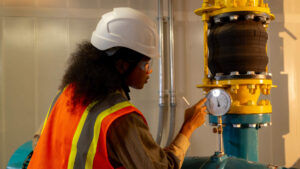D3 Energy looks to get up, up and away on the ASX

Helium hopeful D3 Energy is filling its balloons to bring a listing party to The Australian Securities Exchange. Pic via Getty Images.
D3 Energy is looking to list on the ASX this month under the ticker D3E, supported by a $10 million raising under the stewardship of an experienced leadership team in the energy and gas space.
Helium and methane development company D3 Energy (D3E) is listing on the ASX with independently certified 2C Contingent methane and helium Resources of 475 billion cubic feet (Bcf) and 22.4 Bcf respectively. The company’s permits sit adjacent to a Production Right that is producing liquified natural gas and helium.
D3 Energy has raised $10 million at 20 cents per share to advance projects on an extensive acreage position, centred on Exploration Right 315, located near the town of Kroonstad on a proven helium and methane province in South Africa’s Free State region, in the northern part of the nation. At listing, the company will have 120.795m fully paid shares plus 21.545m options and performance rights with just over $10 million in the bank after costs and project acquisition costs.
Historic gold boreholes in the province and on D3 Energy’s acreage have been measured with a free-flowing gas rate of close to 100,000 standard cubic feet per day, containing up to 6% helium and 80% methane. This helium content compares with other commercial helium sources such as the now depleted Bayu Undan gas field in the Timor Sea, which has a helium content of less than 0.2%.
Helium is a stable, inert, light industrial gas that finds expanding application in the production of semiconductors, in MRI machines, welding and aerospace applications, nuclear energy and other scientific uses.
The price of helium gas has risen dramatically over the past 20 years as strong demand growth exceeds supply.
By 2022 the helium price had risen to US$350 per thousand cubic feet (mcf) after averaging US$80/mcf in 2001.
Currently, spot prices for the gas has been seen at around US$1,150/mcf.
Industry watchers see demand for Helium rising by around 2 Bcf, to a total of around 8 Bcf pa in 2030, putting further upward pressure on price as supply struggles to match demand.
The company also sees prospectivity for conventional, geochemically sourced methane in sandstone reservoirs as well as coal seam methane plus gas of biological origin on its ER315.
The Industrial Gas Users Association – South Africa, estimates that the nation will see demand for 718 petajoules (PJ) of methane gas in 2030, but pipeline supply from Mozambique has peaked, leaving an expanding supply gap of over 100PJ pa and Mozambique project operator, SASOL has publicly stated this supply will in fact cease in July 2026.
In recognition of the need for more gas in South Africa, D3 Energy has attracted shareholder support from integrated energy, technology and domestic gas retailer, NOVO Energy, who will be standing ready to offer support should the company seek to deliver commercial supplies.
Several options, including compressed natural gas and mini-LNG would be available to D3 Energy in the event of commercial production, while the processing, transport and marketing of helium is well established.
D3 Energy plans a programme of low-cost shallow appraisal wells to assess known methane and helium occurrences and test optimal well completion techniques. This work will combine with assessment of geophysical data that can inform future seismic survey programmes, aimed at upgrading Contingent Resource to Reserves and Prospective Resource to a Contingent Resource.
The company’s pathway to market has already been pioneered by Renergen Ltd (RLT) which is producing both liquified natural gas that can be trucked to consumers as well as compressed helium at its neighbouring Virginia Gas project.
D3 Energy is led by a team that has delivered success in conventional and coal seam gas projects. Chairman, Greg Columbus and managing director, David Casey were chairman and CEO Australia respectively of Perth Basin success story, Warrego Energy.
Matt Worner and Casey have worked together at Talon Energy while Zetzman and Ranoszek have deep country knowledge of South African geology and were instrumental in outlining opportunities for both shale and coal seam gas, as wells as helium.
This article was developed in collaboration with D3 Energy, a Stockhead advertiser at the time of publishing.
This article does not constitute financial product advice. You should consider obtaining independent advice before making any financial decisions.
Related Topics

UNLOCK INSIGHTS
Discover the untold stories of emerging ASX stocks.
Daily news and expert analysis, it's free to subscribe.
By proceeding, you confirm you understand that we handle personal information in accordance with our Privacy Policy.








